By Jeffrey A. Rendall, Photos By Kevin Gaydosh
CHARLOTTESVILLE, VA – Ah, reflecting back on college. For most of us, it was a time for taking classes on stuff we’ll probably never think about again, pulling all-nighters when papers were due and celebrating good times with friends (not necessarily in that order). Universities offer so many opportunities for experiencing something new and different in a person’s life, it almost feels mundane once you graduate and leave campus.
The main differences between the ‘real world’ and those four years -- are the daily opportunities to tap the accumulated knowledge colleges present, but also getting a chance to use the facilities they offer, such as libraries, laboratories, eateries, forums, workshops, athletic fields, golf courses…
Golf Courses? My ‘institution’ didn’t have one…?
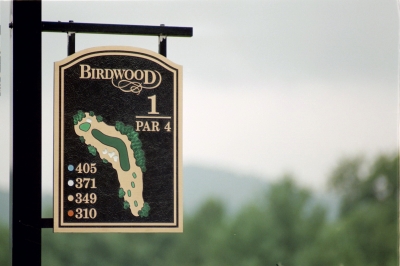 |
| The 1st hole, like each one in succession, is laid out right in front of you at Birdwood. |
A few schools do, though, and the University of Virginia, in Charlottesville, is proud to offer one of the very best, Birdwood Golf Course. There aren’t many universities with their very own golf facility, so when you see one, you know it’s probably got an interesting story behind it – and no doubt, some philanthropy. Birdwood’s no exception.
Opening in 1984, the golf course was laid out on land that was known as Birdwood Farm, and hence, the club adopted the name -- though no one seems to know the origin of the term, ‘Birdwood.’ The golf course was designed by Baltimore based architect Lindsay Ervin, and it was the first ‘solo’ project for his newly established design company.
“I got the job because of Mrs. Nettie Jones,” Ervin said, looking back on a period of time when Mrs. Jones figured prominently in his early golf design career. Ms. Nettie had given Ervin his first golf course project a few years earlier at Hog Neck in Easton, Maryland (he was still working for a DC based A & E firm at the time), and now she was interested in building a golf course in the Charlottesville area for the University.
“Mr. and Mrs. Jones were very fond of golf – Mr. Jones was CEO of a very prominent company (he was killed in a private plane crash) and had the chance to play at a lot of great golf clubs, like Augusta National. When he died, Mrs. Jones owned several pieces of property in the Easton area, and wanted to continue his legacy by contributing money and land to various golf projects that would keep his memory alive. Then, about a year after Hog Neck was completed, Ms. Nettie moved to the Charlottesville area,” Ervin explained.
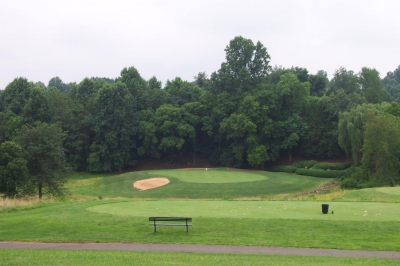 |
| Birdwood has a terrific set of par threes. Here, the downhill, 195-yard 12th hole. |
Soon after, Jones called Ervin and said the University was interested in building a golf course on a piece of land it owned. She was good friends with the President of UVA at the time, and told him she’d match any money the school put into building the new course (which turned out to be about $800,000) – but she had one condition, that being she could get Ervin to design it.
Jones then arranged to fly UVA’s President, Athletic Director and the Director of the Planning Department over to Hog Neck so Ervin could show them his work. Ervin gave them a tour, and they all liked the course -- and approved him as the architect for the new University of Virginia golf course.
Ervin takes it from there: “I was really excited to be able to design Birdwood as the starting project for my newly established company. I loved the beautiful site, and even considered employing the existing Birdwood manor house as the clubhouse.”
They didn’t end up using the mansion, however, because it wasn’t in condition to do so, and besides, its location close to the road wouldn’t really fit into the ‘theme’ of what they wanted to accomplish at Birdwood. As a result, they decided to put the clubhouse on the highpoint of the property, near some existing dairy barns, to provide a panoramic view of the course and surrounding countryside.
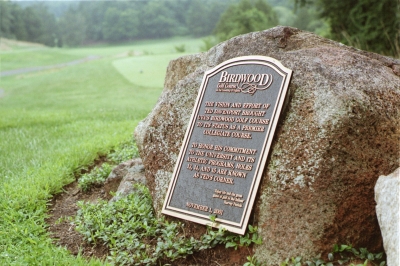 |
| In case you forget this is a college golf course, there are periodic monuments to remind you. |
The clubhouse’s location might have been in dispute, but the land’s natural gifts were agreed upon by all. From the first tee on, you’ll note that there really isn’t any ‘law’ that governs the Birdwood property except variation – quite a wide range of shot challenges – downhill, uphill, side-hill, some with trees, some relatively wide open.
And you’ll see it all as you go along. “I try to give the golfer as much of a view of the entire golf hole as possible from the tee, so he can plan his best strategic attack on the hole,” Ervin said. “The ability to see the entire hole allows him to calculate his percentages of success, should he decide to gamble -- take a specific route that, if successful, will give him a better chance of beating that hole via making a birdie or an eagle. Elevated tee shots are nice, since the entire hole is laid out -- plus the views are usually beautiful.”
“If a player can’t see where his shot will land (a blind shot), then he’s less likely to gamble – he’ll play it safe and hit straight-away and try to keep it in play. That eliminates a lot of the strategy in the game, and lessens the experience,” Ervin added.
‘Calculate the percentages of success?’ Spoken like a true engineer. But I think we get the message.
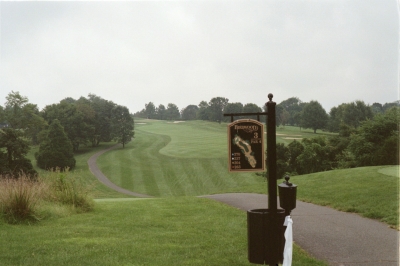 |
| The view from the tee of the 370-yard, par four 3rd hole shows that although the hole plays uphill, you'll still see everything you need to do. |
Along those ‘visual’ lines, Ervin worked hard at Birdwood to eliminate blind shots. Courses with these kinds of elevation changes and topographical variety will invariably have them, but here they’re incorporated into tee shots on par fours or fives – but the landing area’s still defined. No blind par threes at Birdwood, which according to Ervin, is a big no-no.
“The joy in golf is seeing your shot land in the fairway, out of harm’s way, or on the green next to the pin. That’s the experience that brings you back again, and that’s what we really tried to do at Birdwood,” Ervin said.
Interesting as it is, the two-decade history of Birdwood Golf Course constitutes only a fraction of the property’s total story. Kevin Kelley, Director of Sales and Marketing for Birdwood (and the Boar’s Head Inn, next door), helps out with the years prior to construction: “Birdwood farm was a prized piece of land from the beginning, going back to 1819 when the manor house was built by a gentleman named William Garth. Garth called the property ‘Upland Wilderness,’ and the land where the golf course was built was originally part of a 2300 acre tract.”
‘Upland Wilderness’ subsequently went through a couple sales, owners and ‘uses,’ being utilized as a sheep ranch well into the late 19th century – then it was used to raise prize Angus and Hereford Cattle. The University of Virginia acquired the land in the early 1970’s, and the rest, you might say, is history.
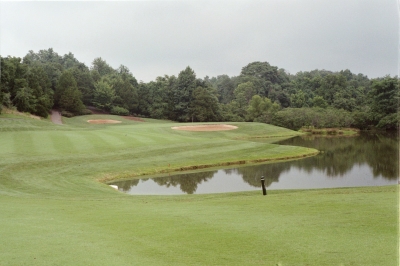 |
| Looking towards the green on the par four 13th hole. Here's a hole where you can't see the water from the tee, but you'll still know where to land the ball. |
Kelley said there’s currently some discussion on what to do with the Birdwood mansion, though there’s a lot of renovation work to be done before it would be safe for public use.
Back to golf – as hinted at above, Birdwood is more than just eighteen holes owned by a University. It’s a rolling adventure through a heavily forested piece of property with some beautiful scenic views and plays quite challenging. Perhaps best of all, there isn’t any real estate bordering its fairways.
And Birdwood’s more than just the land it’s on… it’s the soil, too. “One of the neat things about this whole area, called the Piedmont,” Kelley says, “is that about thirty miles east of here starts the Atlantic Coastal Plain. The reason why Jefferson, Madison and Monroe settled in these parts is because of the soil – they were farmers first and statesmen second. Because of the nourishing soil, everything grows prodigiously here.”
Just the mention of Jefferson’s name in Charlottesville is sacred. He was the UVA’s founder and first President, an accomplishment that he thought so highly of that he put it on his grave marker – and doesn’t even mention being President of the United States. So much for prioritizing accomplishments.
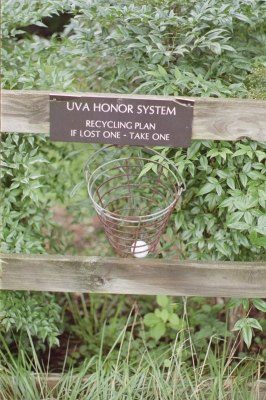 |
| At Birdwood, you might lose a few golf balls, but the 'UVA Honor System' will help replace them. |
At any rate, there’s good soil at Birdwood, which helps explain why the course is so lush and green. We played in the heat of summer and the Bermuda grass was extremely thick. Despite the prevalence and thickness of the grass, Kelley says they’re in the midst of installing additional irrigation, which will keep the rough areas more consistent during years where we don’t get pelted with rain, like this year (2004).
They’re also re-doing the bunkers, which again will help with consistency.
Speaking of consistency (or perhaps, the lack of change), other things have changed at Birdwood that will hopefully be ‘restored’ to their original conditions. Such is the case for the 10th green, which Ervin said was specifically designed to showcase the panoramic views of the mountains offered from this part of the property. Now, however, the trees have grown so tall and dense that you can no longer see the view – and Ervin mentioned that he hopes the trees can be replanted elsewhere to open up the scenery, once again.
Hole highlights are many, but we particularly enjoyed the fourth hole, an aesthetically pleasing 179 yard par three with a tricky green. There’s a lake (fed by a natural spring) guarding the front and right sides, and bunkers to the left and long. The green is large, however, but very sloped.
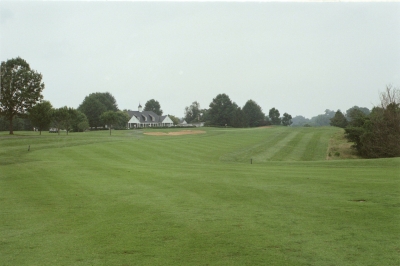 |
| A great way to finish up on 18, right in front of the clubhouse. |
According to Ervin, there’s a tale behind that, too: “The Superintendent at the time was a bit of a want-to-be golf course architect, and asked me if he could work with the contractor to grade the green how they’d like to see it. I told him it was alright as long as the slopes could be maintained, and there were enough cupping locations to allow the hole to play differently.”
“Well, they made quite a green, very sloped and almost impossible to putt. I learned a lesson from that incident – I’ll no longer allow anybody to change or ‘do their own thing’ with the designs on our courses as long as we’re in charge of design items,” Ervin said.
Despite Ervin’s reservations about the fourth green, it, along with the entire course, was a joy to experience. Because Birdwood is a college course (it's owned by the UVA Foundation and operated by The Boar's Head Inn as one of its many amenities), it’s also one of the better golf bargains you’re going to see in the region. There will always be students playing (that’s what it’s for, after all), and you’ll feel the tangible school spirit out there (blue and orange tee markers).
It’s almost ‘intoxicating,’ just like the old college days… except for maybe the hangovers.
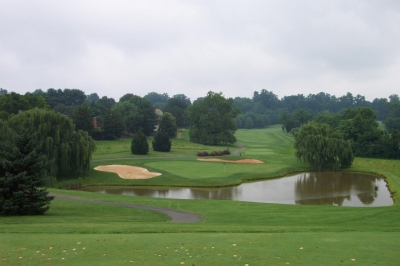 |
| The par three 4th hole -- tricky green, beautiful view. |
Where We Stayed
For those unfamiliar with this part of Virginia, you’re truly missing out. Central Virginia’s rolling hills and majestic hardwood forests are about as beautiful and scenic as you’ll find anywhere.
It’s much more than just Jefferson’s Monticello, though you certainly can build a vacation around the 3rd President’s lifetime work – even a golf vacation.
We chose to stay at the Boar’s Head Inn in Charlottesville. Owned and operated by the University of Virginia, this is far from what you’d call a college dormitory. The ‘Boar’s Head’ part originates from Shakespeare’s era in England, when the boar’s head symbolized good food and hospitality.
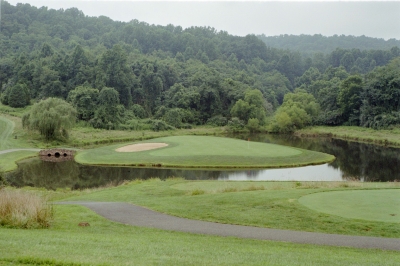 |
| Pete Dye's not the only one who designs island greens. Here, the 158 yard, par three 14th hole. |
That’s precisely what you’ll get at the Boar’s Head Inn, along with some attractively manicured grounds, spacious guest rooms (most with patios or balconies), and conveniently located next door to Birdwood Golf Course.
The Boar’s Head Inn – the name’s a bit deceiving – offers a full range of resort amenities, a lot more than you’d expect from ‘just’ an Inn. There’s a Spa with treatment rooms, a Sports Club with tennis and fitness equipment and even activities such as Hot Air Ballooning during certain times of year.
Don’t forget to eat – as if you would. Simply put, the Boar’s Head Inn’s dining experience is as fine as we’ve seen this season, both in service and cuisine. We chose dinner at the Old Mill Room, where the dress is casually elegant, and so is the atmosphere. Rated four-diamonds, the fare in the Old Mill Room is worthy of an Inn with a reputation for good food and hospitality. And don’t get me started on the wine list – you’ll need a separate sitting just to read it.
The Boar’s Head Inn is quite busy during the UVA school year, but spacious enough to accommodate visitors from just about anywhere. Needless to say, it’s highly recommended, and we’re looking forward to going back.
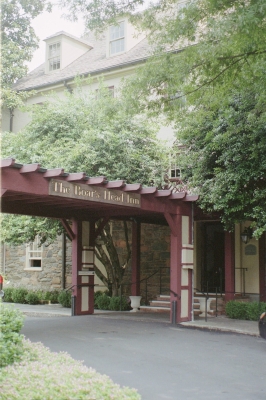 |
| Stay next door to Birdwood at the Boar's Head Inn. |
Check the website: www.boarsheadinn.com for further information, or call (800) 476-1988, or local (434) 296-2181.
Details:
Birdwood Golf Course at the
Phone: (434) 293-GOLF (4653)
Weblink: http://www.boarsheadinn.com/activities/birdwood/
Course Designer: Lindsay Ervin
Head Golf Professional: Martin Winters, PGA
Course Superintendent: Matt Wade
Director of Sales & Marketing: Kevin Kelley
Tees/Yardage/Slope/Rating
Blue 6865 132/73.2
White 6285 126/70.3
Gold 5739 120/68.1
Orange 5041 122/72.4
Rates:
Until November 30, 2004, greens fees M-Th are $50. Fri-Sun: $60. Carts are $18. After 4:30, it’s $28, plus the cart if you want it (check the website for current twilight starting times).
December 1 through March 25th, 2005, M-Th it’s $25, weekend it’s $35. So, December 1st, it’s $53 with a cart on the weekends and $43 on the weekdays.
| Related Links | Comments on this article? | |
|
Maryland National Golf Club Hollow Creek Golf Club Rocky Gap Resort PB Dye Golf Club in Ijamsville Whiskey Creek Golf Club |
E-mail Jeff Rendall, Editor: jrendall@golftheunitedstates.com |












